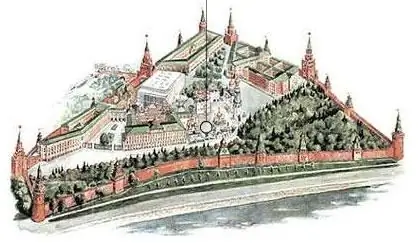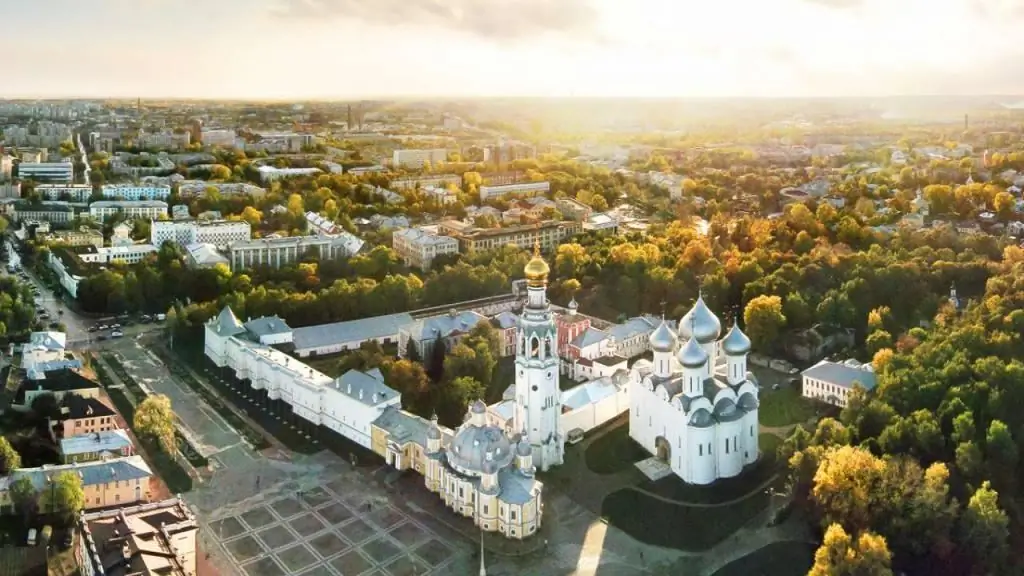- Author Harold Hamphrey [email protected].
- Public 2023-12-17 10:06.
- Last modified 2025-01-24 11:10.
It is believed that the history of Moscow's Garden Ring begins in the 19th century. Then the ditch dug around the old city was filled up, and the Earthen rampart was torn down. At this place, houses with gardens and front gardens began to appear, streets were formed that were located around the capital.
Earth City
In 1591, by order of Boris Godunov, earthworks began around Moscow. During the year, a shaft was poured, and an oak wall was erected on top of it, towering about 5 meters. It had about a hundred deaf and 34 exit towers. In addition, a ditch was dug along the outside of the rampart, which was subsequently filled with water. The need for such a fortification around the city arose after Moscow was subjected to a devastating raid by the troops of Khan Kazy-Girey.

The residents of the city dubbed this building Skorodom, the official name is Earthen City. They also began to call the territory located between the White City and the rampart and the Moscow River. Small merchants, artisans and peasants lived here. ButZamoskvorechie was populated mainly by archers. That is why this place was also called Streletskaya Sloboda.
In the Time of Troubles (1598-1613), the oak walls, along with the towers, burned down, but the moat remained. Later, a palisade of thick logs pointed at the top was placed on it.
The Second Life of the Earthen Wall
At the end of the 17th century, this fortification lost its original purpose. It was turned into a kind of customs border line of the city. From different sides before the entrances to Moscow there were markets. The most famous of them were Smolensky and Sukharevsky.
Towards the end of the 18th century, the rampart, and with it the prison, partially collapsed, and in their place were formed driveways and entire squares. In 1812, all the buildings on both sides of its walls were destroyed by fire.
Formation
In 1816, it was decided to demolish the remains of the Zemlyanoy rampart, and bury the crumbling and shallow ditch. The Moscow Development Commission planned the creation of a wide ring street paved with cobblestones on this site. Under the sidewalks and the pavement, 25 m were taken out of the total distance between the two lines of houses, which then reached 60 m. In the remaining space, the homeowners were obliged to set up front gardens at their discretion. This is how the Garden Ring (Moscow) began to form.

Already by 1830, this project was practically implemented. Only a few sites located in Zamoskvorechye and squares remained without front gardens. Smolensky and Zubovsky shafts turned into boulevards,and Novinsky - to a place intended for folk festivals, and so it remained until 1877.
The Garden Ring (Moscow) gradually developed. In the 70s of the 19th century, tracks were laid there for trams moving with the help of horse traction. This type of transport was called a horse-drawn carriage. In 1912 it was replaced by a more modern one. These were already electric trams. The route they took was officially called "B", and the people dubbed it "bug".
Early 20th century
At the beginning of the century, the Garden Ring (Moscow) began to be intensively built up. Where until recently there were low-rise buildings, not only administrative and commercial, but also residential high-rise buildings have appeared.

As you know, the beginning of this century was not calm. In 1905, during the revolution, fierce battles were fought on the squares and streets that are part of the Garden Ring. Its western part was especially densely dotted with barricades, which were designed to protect the workers' districts. The most bloody clashes between government troops and revolutionary detachments took place on Kudrinskaya, Krymskaya and Zubovskaya squares.
After the victory of the October Revolution of 1917, workers moved into previously erected tenement houses, which were requisitioned from their owners. In addition, new public and residential buildings were being built, and the Smolensky and Sukharevsky markets were soon closed.
Further transformations
In the 30s, they began to implement a plan for the reconstruction of the capital, during which it wasthe Garden Ring is closed. Moscow and its appearance gradually changed. The cobblestone pavement was filled with asph alt. They also significantly expanded the roadway by demolishing the front gardens, and the trams running along route B were replaced with new trolleybuses. But still, the movement of transport in full was organized only in 1963. Two bridges were built across the Moscow River: Krasnokholmsky and Krymsky.
When the Great Patriotic War began, the Garden Ring was fortified in places with protective structures. And in the middle of the summer of 1944, after the defeat of the Nazi troops in Belarus by the Soviet Army, a huge line of prisoners of war captured in battles was carried out through it.

After the end of the war, the grandiose reconstruction of the capital continued. The Garden Ring was one of those objects to be transformed. Moscow, the photo of which has been preserved since those times, gradually acquired a more modern look. Starting in 1948 and over the next 6 years, three of the seven most famous Stalinist skyscrapers were erected in the Garden Ring area.
In the 50s, the Koltsevaya metro line was laid, the southern part of which from the Park Kultury station to the Kurskaya station passed under it. In the next decade, the Garden Ring continued to be reconstructed. Some of its streets have expanded even more and turned into modern avenues with underground passages, overpasses, interchanges and tunnels. In the mid-90s, heavy trucks were banned from passing through it.
Meaning
This is one of the most importanthighway interchanges of the city. The length of the Garden Ring in Moscow, a circular highway encircling the central part of the capital, is 15.6 km with a width of 60-70 m. It is the innermost of the three existing highway tracks, and also the oldest. The Garden Ring is extremely busy, so many kilometers of traffic jams often form here. However, despite this, it still adequately performs its functions.
Squares
The Garden Ring includes 18 squares: Triumfalnaya, Samotechnaya, Malaya and Bolshaya Sukharevsky, Lermontovskaya, Red Gates, Zemlyanoy Val, Caesar Kunikov, Kursk Station, Taganskaya, Paveletskaya, Serpukhovskaya, Kaluga, Krymskaya, Zubovskaya, Smolenskaya- Sennaya, Smolenskaya and Kudrinskaya. Some of them are large, while others are less significant and little known even to Muscovites.
Usually the story about the Garden Ring begins with Triumphal Square. And this is not at all accidental. Once upon a time, the present Triumphalnaya Square, which received this name in 1992, served as the central front gate of Moscow. Previously, she bore the name of V. V. Mayakovsky.

At first, at this place, at the Tver Gates, a rather extensive settlement of the Earthen City arose. By the 17th century, the square became a market place, and then the first Arc de Triomphe, built of wood, appeared on it. Gradually, this territory was built up with houses, and where the Aquarium Garden is now located, there used to be a pond and vegetable gardens belonging to the Novodevichy Convent.
Modern lookthe area was received in the 30s, when the square was cut down, and the territory was asph alted. After a monument to V. V. Mayakovsky was erected here, it turned into a popular place for various poetry readings.
The most "inconspicuous" squares are Krymskaya and Tsezar Kunikov squares. The second of them is named after the hero of the Soviet Union who participated in World War II. There is not a single house on this square, since they all belong to the nearest streets. Only a memorial plaque reminds of Kunikov himself.

Streets
In addition to the squares, the Garden Ring also includes many streets. The longest of them is Zemlyanoy Val. Its length is more than 2000 m. In 1938 it was renamed Chkalovskaya, as the famous Soviet pilot V. P. Chkalov once lived here. The old name of the street was returned only in 1990. In addition, it is associated with many famous names of people who lived and worked here at different times. For example, writer S. Ya. Marshak, aircraft designer V. M. Petlyakov, academician A. D. Sakharov, artist K. F. Yuon and many others.
Like the squares, all the streets of the Garden Ring (Moscow) have their own history. And this is not surprising, since the capital has a long history. Sadovaya-Karetnaya Street is considered the shortest, that's why its length is only 406 m. It appeared at the beginning of the 19th century. Its double name is associated with the gardens that once grew here and the street located in the neighborhood, called Karetny Ryad. Almost all the houses of the old building were demolished in the 70s.last century.

Where to stay
Almost every tour of the capital in one way or another affects the Garden Ring. And there is something to see here. By the way, the Garden Ring Hotel (Moscow) provides its services to tourists. Its building is located at the intersection of the transport highway of the same name and Mira Avenue, which is in the business center of the city. Not far from it are Red Square, the sports complex "Olympic", the Botanical Garden and the Institute. N. V. Sklifosovsky. "Garden Ring" - a hotel (Moscow), which is ideal for both tourists and business people.






